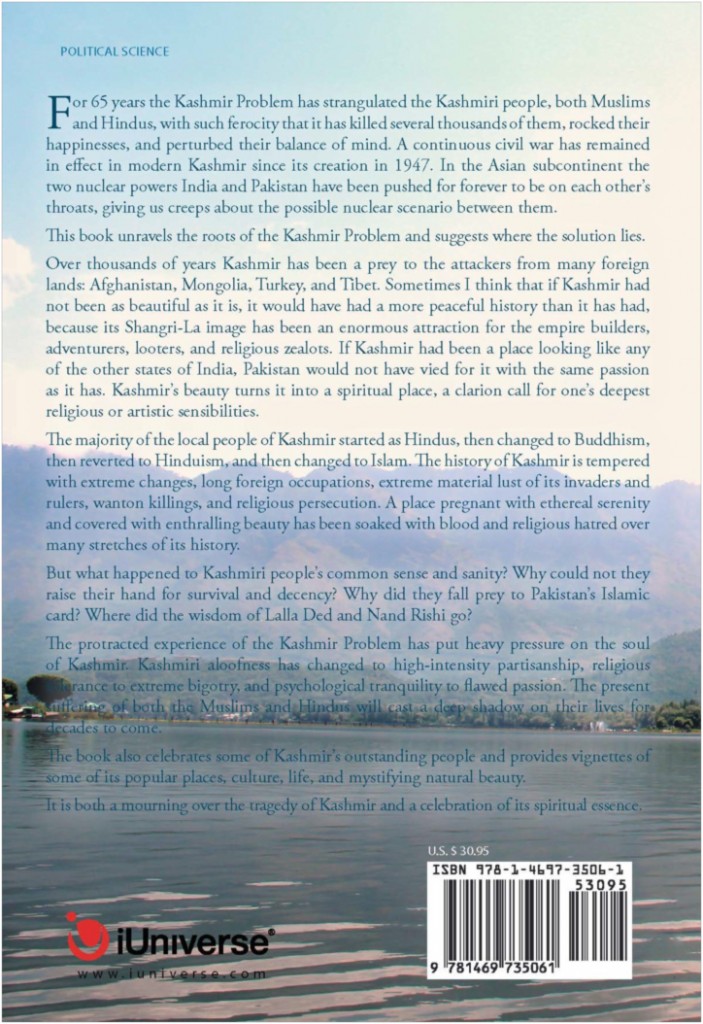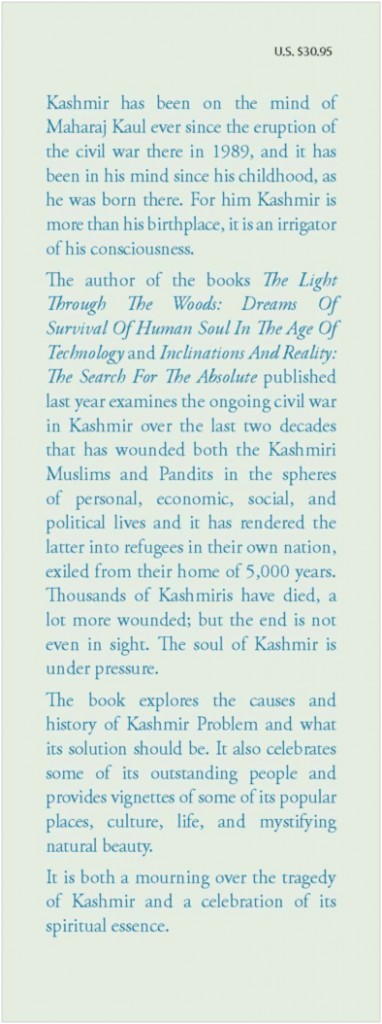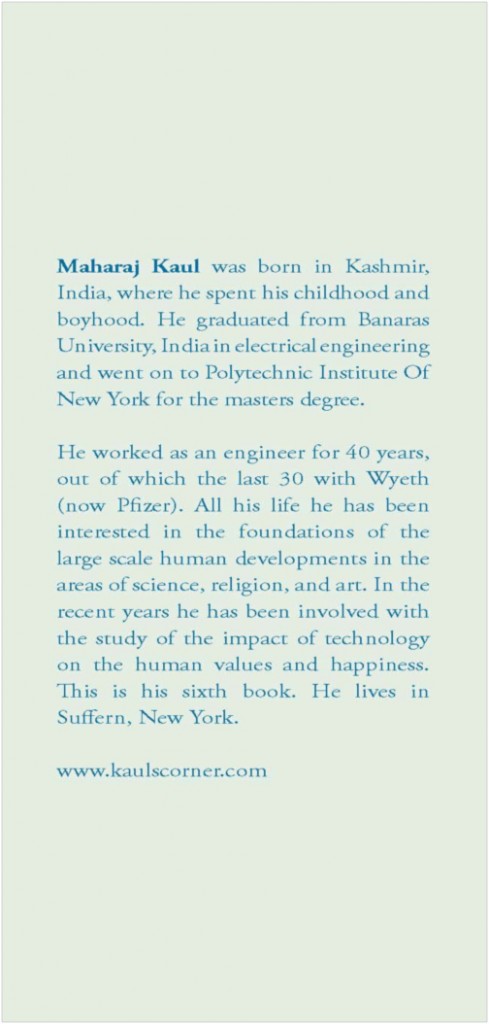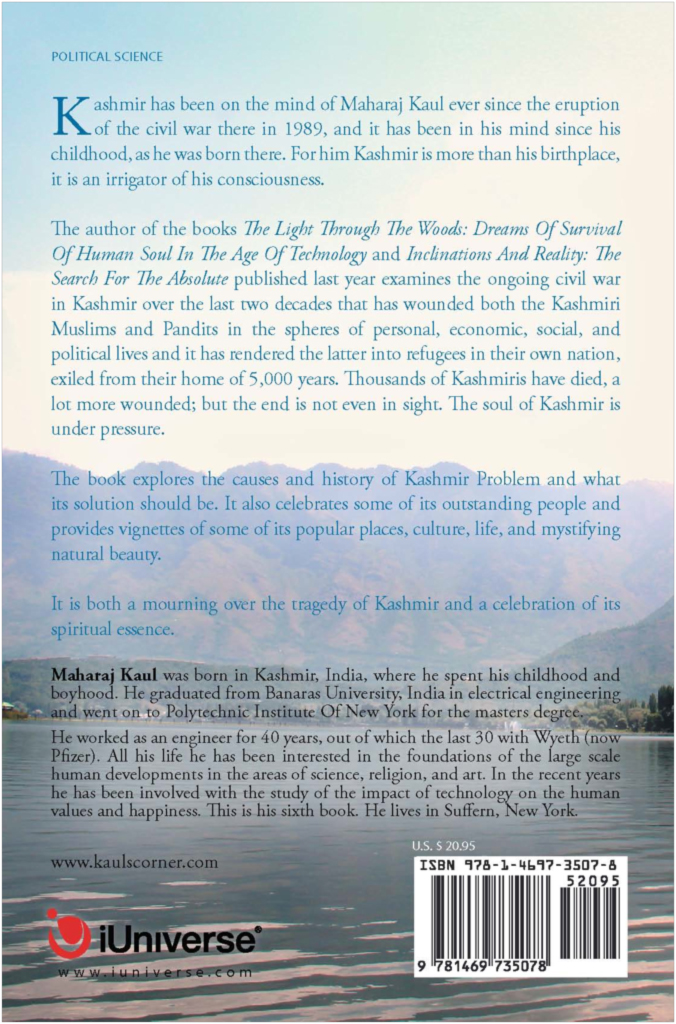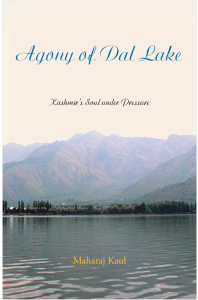A Long Enduring Heartbreak
Introduction To The Book
Kashmir has been in my mind ever since I gained a consciousness to connect my observations with some sort of a thinking process. Obviously, it was due to my having been born there.
During my childhood I was ever conscious of the backdrop of the high mountains encircling me, no matter where I went. Also, life in Kashmir seemed to be secluded, a self-contained universe, with little interference from the outside. This contributed to the fairly-tale existence of my childhood.
Whether it was the enigmatic beauty of Kashmir, or my own inclination, which made me a thinker, I do not know. But my childhood was studded with a veil of mystery surrounding human existence. My growing up became a gradual unveiling of that mystery.
At the time of my birth Kashmir was a peaceful place, which from time to time was jolted by Sheikh Abdullah’s assault on its undemocratic governance by the reigning Dogra monarchy. Kashmir went through the birth pangs of the new nations of India and Pakistan, but without being a part of the either. This orphanhood was self-inflicted by Maharaja Hari Singh. He harbored the fantasy of an independent nation of Kashmir. While he was going through the Micawberish state of mind, hoping for the best but without doing anything about it, Pakistan tried to exploit an inviting opportunity, while the Maharaja was in deep meditation on what to do and India was busy taking control of the reins of the new nation. It struck Kashmir under the camouflage of a northern Kashmir tribal revolt against its government. Sheikh Abdullah, a staunch follower of Gandhi and Nehru, and latter’s personal friend, had rejected Kashmir’s integration with Pakistan and thrown its lot with India. Pakistani forces were stopped and repulsed to a point which left about one-third of Kashmir with Pakistan, when the U.N. sponsored truce was put in effect. Sometime after assuming the prime ministership of Jammu and Kashmir, Sheikh Abdullah recalled back his old fantasy of an independent nation of Kashmir. This situation of Pakistan’s attack on Kashmir to absorb it and Sheikh Abdullah’s change of mind about integration with India engendered the six-decade old intractable problem called Kashmir Problem. This was the beginning of the heartbreak of Kashmir.
Subsequently, Kashmir Problem became more and more unyielding, as the successive Indian central governments mishandled or did not handle at all the persistent viciousness of Pakistan in nullifying India’s advantages over it of providing Kashmiris with a democratic frame of government, pouring a vast economic aid, and a hands-free approach to their government. Indian government was not able to stand up to Pakistan’s shenanigans and Kashmiris’ vacillation and week spine. Then there were incompetent and corrupt Kashmiri leaders, some of whom had divided loyalty to both the sides.
But what happened to Kashmirii people’s common sense and sanity? Why could not they raise their hand for survival and decency? Why did they fall prey to Pakistan’s Islamic card? Where did the wisdom of Lalla Ded and Nand Rishi go?
The Hindu-Muslim divide in Kashmir is more than 600 years old but there have been many long stretches of amity and peace between them. During the partition of India and Pakistan in 1947, when about a million people were killed, not a single person died in Kashmir. (Deaths in Kashmir in 1947 came from the Pakistani attack to grab it and not due to the partition) This accord between the people was not accidental but due to many efforts made by wise and common men from both sides over a long stretch of time. During the almost 500 years of Muslim rule in Kashmir there was never any serious attempt made to break Kashmir into Hindu and Muslim parts of the state or into two states. But exploited by the evil greed of Pakistan and seduced by the worldwide Islamic fundamentalist movement, Kashmir Muslims lost their balance of mind and expelled the Pandits out of the Kashmir province.
The protracted experience of the Kashmir Problem has put heavy pressure on the soul of Kashmir. Kashmiri aloofness has changed to high-intensity partisanship, religious tolerance to extreme bigotry, and psychological tranquility to flawed passion. The present suffering of both the Muslims and Hindus will cast a deep shadow on their lives for decades to come.
Kashmir Problem has been on my mind since its phase-two inception in 1989. I have been obsessed about it. I have thought about it, written about it, and spoken about it. This is because it represents a violation of my sacred homeland, my birthplace, where the foundations of my mind were cast. Kashmir has been the scene of my childhood, boyhood, and early adulthood. Its desecration is a knife-stab through my heart.
The 20 articles on the Kashmir Problem were written over 21 years. They were started at the time of the inception of the present civil war in Kashmir in 1989. They were written as the state of mayhem, chaos, and exodus of Kashmiri Pandits, shifted from one peak to another, as each significant step for peace was knocked out, as each period of calm and constructiveness was shattered into hopelessness and misery by their enemies. The articles were meant for Kashmiris as well as for non-Kashmiris. They were written with anguish, at the moment of passion, but structured with a fabric of reason, and imbued with a lot of hope. Obviously, there is a lot of repetition in them, because though they were written at different times, they were on the same subject. They remind the readers that Kashmir problem did not have to have happened, if we had the right quality of leadership present at Kashmir and the central governments. Much frustration and heartbreak emanate from the articles, as I believed that the tragedy in Kashmir was man-made. At some point in future the problem will start attenuating, when we have the right leadership. This is especially more significant at the Kashmir end. Kashmiri leaders have been weak and corrupt, as they have let the masses bleed to secure their power and pages in history. A morally upright Kashmiri leader, concerned about the welfare of his people, would have arrived at a settlement with India a long time back. Throwing Kashmir’s lot with Pakistan is suicidal and its independence would amount to the same thing, as shortly after achieving it, it would crumble into Kashmir’s usurpation by Pakistan.
Kashmir people are not insecure about losing their land in their relationship with India. They are not insecure about practicing their religion of Islam under Indian nationhood. Kashmir cannot survive alone, as it does not have an economic base, and also it does not have the necessary military power to fend off Pakistan from usurping it. If its leadership had been honest and competent, as it was up to a point in the time under Sheikh Mohammad Abdullah, it would have continued to have an accord with India, as it did until August 9, 1953, when he was arrested for his separatist activities. Clamoring for more autonomy than what it already has is just an excuse for being closer to the state of independence. Islamization of Kashmir is another chimera of Kashmiris’ troubled mind.
This book is about Kashmir Problem and vignettes of some of its places and people. Also, it contains 12 poems on it. The title of the book comes from the title of one of its poems Agony Of Dal Lake. Dal Lake is the most symbolic representation of Kashmir. Agony of Dal Lake is the agony of Kashmir. In the poem Dal Lake speaks about the pains, desecration, and humiliation it has experienced since 1989 due to the ongoing civil war among its children.
The heartbreak of Kashmir continues unabatedly. I do not believe it will be over within my lifetime.
Note: The articles and poems have been presented in the descending chronological order.
